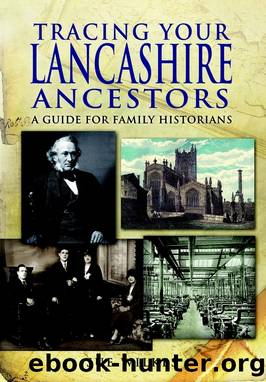Tracing Your Lancashire Ancestors by Sue Wilkes

Author:Sue Wilkes
Language: eng
Format: epub
ISBN: 9781783035649
Publisher: Pen & Sword Books
Published: 2013-05-22T00:00:00+00:00
Census Returns
The enumeratorsâ summary books were bound into volumes (âpiecesâ). Because each summary book had numbered pages, each page number would recur, so to make it easier to identify each record, the front of each page was stamped with a âfolio numberâ. So for 1841â1901, each page of the book is defined by a unique reference number comprising four parts. The first part is the original Home Office or Registrar General series code, followed by a âpiece numberâ, folio number and page number (each folio number relates to two pages).
For example, the 1851 census return for Bolton Registration District enumeration district number 1e, Bolton Western Sub-Registration District, has a TNA reference number: HO 107/2211, folio 162, p. 20. This refers to Home Office series 107, piece 2211, folio 162, p. 20.
For the 1911 census, the household schedules were preserved as well as the summary books, and colour images of schedules are available online. Each schedule was completed and signed by the householder. The 1911 census schedules were extremely detailed. For the first time, married women were asked how many children were born alive in their current marriage, how many had died and how many were still alive.
The 1911 census schedules and summary books are linked by a unique reference number comprising three parts: Registration District Number (RD), Registration Sub-District Number (RS) and Enumeration District Number (ED). Each summary book correlates to its own set of schedules.
A detailed discussion of the variations in the types of data gathered by each census is beyond the scope of this book: see Peter Christian and David Annal, Census: The Expert Guide (TNA, 2008), which includes case studies and the 1911 census, and Edward Higgs, Making Sense of the Census Revisited: Census Records for England and Wales 1801â1901 (Institute of Historical Research/TNA, 2005).
The census returns for England and Wales are kept by TNA; they can be viewed on microfilm at Kew and at local archives and reference libraries. LRO holds copies of censuses for Lancashire for 1841â1901. Local record offices and reference libraries may only keep censuses for their particular area, but many offer free access to one of the subscription services.
Census returns for 1841â1911 have been digitized, transcribed and indexed and made available online (see Section E). Lancashire County Libraries offers free access to the Ancestry website via its library computers. Census returns are also available at FamilySearch (the Church of Jesus Christ of Latter-day Saints) centres (see Section C).
Some free census returns for Lancashire have been transcribed by volunteers and put online (see Section D). The Lancashire Family History and Heraldry Society has published some 1851 transcripts and indexes for the North Lancashire and the Fylde areas. Indexes and/or transcripts for several Lancashire towns have been printed in book form, fiche or CD-ROM by family history or record societies.
The Society of Genealogistsâ Library has some surname indexes, place-name indexes and returns for Lancashire censuses. It also has some copies of censuses prior to 1841 and census âsubstitutesâ such as lay subsidy rolls (see the Societyâs online library catalogue).
Download
This site does not store any files on its server. We only index and link to content provided by other sites. Please contact the content providers to delete copyright contents if any and email us, we'll remove relevant links or contents immediately.
| Africa | Americas |
| Arctic & Antarctica | Asia |
| Australia & Oceania | Europe |
| Middle East | Russia |
| United States | World |
| Ancient Civilizations | Military |
| Historical Study & Educational Resources |
Machine Learning at Scale with H2O by Gregory Keys | David Whiting(4183)
Never by Ken Follett(3791)
Fairy Tale by Stephen King(3220)
The Man Who Died Twice by Richard Osman(2997)
Oathbringer (The Stormlight Archive, Book 3) by Brandon Sanderson(2881)
Will by Will Smith(2793)
Rationality by Steven Pinker(2291)
The Dark Hours by Michael Connelly(2243)
Can't Hurt Me: Master Your Mind and Defy the Odds - Clean Edition by David Goggins(2228)
The Dawn of Everything: A New History of Humanity by David Graeber & David Wengrow(2122)
Friends, Lovers, and the Big Terrible Thing by Matthew Perry(2119)
Principles for Dealing With the Changing World Order: Why Nations Succeed and Fail by Ray Dalio(1974)
HBR's 10 Must Reads 2022 by Harvard Business Review(1777)
A Short History of War by Jeremy Black(1762)
Go Tell the Bees That I Am Gone by Diana Gabaldon(1687)
515945210 by Unknown(1599)
A Game of Thrones (The Illustrated Edition) by George R. R. Martin(1589)
Kingdom of Ash by Maas Sarah J(1526)
443319537 by Unknown(1470)
